Copyright © 2019 by Stefan Schwope
 Schwope
Schwope
| Veröffentlichungen | |

DIN SPEC 91333 |
Seit 05.09.2014 Mitarbeit an der DIN SPEC 91333, 'Gestensteuerung zur Mensch-System-Interaktion', DIN Deutsches Institut für Normung e. V. Einführungsbeitrag Diese DIN SPEC enthält Anleitungen und Empfehlungen zur Gestaltung der Benutzerschnittstelle von berührungsloser Gestensteuerung in der Mensch-System-Interaktion. Bestandteile dieses Dokumentes sind zentrale Begriffe, Darstellung des Prozesses der Gestensteuerung und die Beschreibung, Kennzeichnung und Darstellung (Illustration) von menschlichen Gesten. Des Weiteren werden Grundregeln zur Gestaltung intuitiver oder erlernbarer Gesten definiert. Des Weiteren werden Standardgesten zur Bedienung anwendungsunabhängiger Kernfunktionen von Systemen mit Gestensteuerung vorgestellt, indem sie in ihrer Funktion und als exemplarischer Gestenkatalog dargestellt werden... |
|
|
|
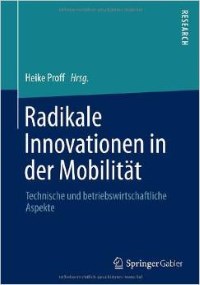
Hrsg. Heike Proff |
C. Peter, S. Schwope: 'Time-of-Flight basiertes Handtracking als Bedienelement im Fahrzeuginnenraum', Radikale Innovationen in der Mobilität,
2014, Springer Gabler, ISBN 978-3-658-03101-5 Einleitung Trotz intensiver Forschung in der Gestenerkennung sind weiterhin Tasten, Hebel und seit neuerem Dreh-Drückregler die vorherrschenden Möglichkeiten, Einstellungen an Fahrzeug- und Gerätefunktionen vorzunehmen. Die Bewegungsrichtungen der Finger entsprechen dabei in vielen Fällen nicht denen des Cursors im Bordcomputermenü. Eine Abwärtsbewegung des Cursors verlangt auch in aktuellen Automodellen oft die Rechtsdrehung eines Drehknopfes... |
|
|
|
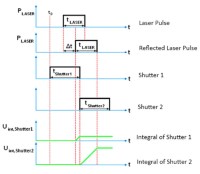
TriDiCam Time-of-Flight Verfahren |
S. Hussmann, M. Gonschior, B. Büttgen, C. Peter, S. Schwope, C. Perwass, M. Johannesson and E. Hällstig, West Coast University of Applied Sciences, Germany and others:
'A Review on Commercial Solid State 3D Cameras for Machine Vision Applications', Nova Science Publishers, Inc. 2013 Abstract Perception of the environment in 3D has always been an important sensory input for machine vision applications. 3D imaging sensors have been investigated for several decades. Recently, novel solid state 3D technologies have emerged, leading to 3D vision systems with radically improved characteristics. At present these new technologies make full-range 3D data available at high frame rates, and thus open the path toward a much broader application of 3D vision systems for machine vision applications. This book chapter reviews state-of-the-art commercial solid state 3D cameras and presents their working principle, their range measurement precision and linearity, and typical machine vision applications. At the end of the book chapter the pro and cons of each technology are listed and the latest camera model of each technology is presented. Hence the reader will be aided in selecting the most suitable 3D camera for a given machine vision application. Furthermore the advantages of a 3D vision system over a conventional 2D vision system are demonstrated through the examples. |
|
|
|
|
LDPD Pixel Structure |
Suss, A.; Nitta, C.; Spickermann, A.; Durini, D.; Varga, G.; Jung, M.; Brockherde, W.; Hosticka, B.J.; Vogt, H.; Schwope, S.:
'Speed considerations for LDPD based time-of-flight CMOS 3D image sensors', ESSCIRC 2013 Abstract Recently a 128×96 pixel range imager with a pitch of 40 µm and a fill factor of 38 % was presented for 3D range imaging measurements based on the pulse modulated (PM) time-of-flight (ToF) principle. This sensor employs a high-speed photodetector called lateral drift-field photodiode (LDPD). During the characterization insufficiencies in charge transfer were observed for low-light illumination. Here, characterization and analysis of the former imager is given and a redesign that circumvents the parasitic effects is demonstrated and verified by measurements on chip and on camera level. |
|
|
|

Twitter @SSchwope |
Twitter @SSchwope |
|
|
|
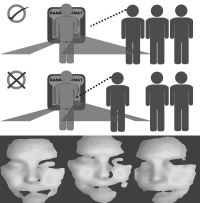
Security-Applications |
Clu - Menschen und Wissen einfach verbinden Abstract This paper gives an idea of how the TriDiCam CMOS 3D Sensor Technology works and in which ways it can be used on various security systems. After a short overview about the TriDiCam 3D Technology, different applications for 3D sensor technology in security business are given. |
|
|
|

intelligente Schiebetür |
Clu - Menschen und Wissen einfach verbinden Einleitung Normale Schiebetüren können nicht erkennen ob Fußgänger auf die Tür zu oder nur an ihr vorbei gehen. Die Folgen sind z.B. höhere Wärmeverluste in Gebäuden, höhere Wartungskosten der Tür oder höheres Krankheitsrisiko durch mehr Zugluft. |
|
|
|
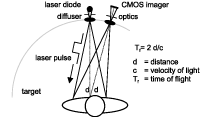
Bild 1 |
Jahrestagung 2011 der Initiative Bildverarbeitung e.V. Inhalt Die Entwicklung Lichtlaufzeit basierter 3D Sensoren hat in den letzten Jahren deutliche Fortschritte gemacht. Bild 1 zeigt die prinzipielle Funktion eines 3D ToF Sensors. Die Objekte einer Szene werden mit einem räumlich ausgeweiteten Laserpuls stroboskopartig beleuchtet. Das von den Objekten reflektierte Licht wird von einem Objektiv gesammelt und auf einem Bildsensor fokussiert... Gastgeber: 16. Juni 2011, Fraunhofer MEVIS Maria-Goeppert-Str. 1a 23562 Lübeck Prof. Dr. Bernd Fischer |
|
|
|
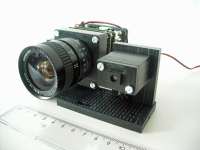
TriDiCam Test Camera |
Andreas Spickermann, Daniel Durini, Andreas Süss, Wiebke Ulfig, Werner Brockherde,
Bedrich J. Hosticka, Stefan Schwope and Anton Grabmaier: 'CMOS 3D Image Sensor Based
on Pulse Modulated Time-of-Flight Principle and Intrinsic Lateral Drift-Field Photodiode
Pixels', ESSCIRC 2011 Abstract Design and measurement results of a CMOS 128 x 96 pixel sensor are presented, which can be used for three-dimensional (3D) scene reconstruction applications based on indirect time-of-flight (ToF) principle enabled by pulse modulated active laser illumination. The 40µm pitch pixels are based on the novel intrinsic lateral drift-field photodiode (LDPD) that allows for a 30ns complete charge transfer from the photoactive area into the readout node, and accumulation of signal charge over several readout cycles for extended signal-to-noise ratio (SNR). Distance measurements have been performed using a specially developed camera system. |
|
|
|

3D Hand mit TriDiCam Sensor |
S. Schwope, INSPECT Ausgabe 3/2011 Neue Form der Laufzeit-Messung 3D-Time-of-Flight-Technologie mit indirektem Pulslaufzeit-Verfahren In unserer dreidimensionalen Welt müssen Sensor-Systeme zukünftig in der Lage sein, alle drei Dimensionen zu erfassen – und zwar in Echtzeit. Das ermöglichen jetzt neuartige 3D-Bildsensoren auf Basis der Time-of-Flight-Technologie. Ein patentiertes Pulslaufzeit-Verfahren vermeidet zudem Mehrdeutigkeiten und unterdrückt störendes Hintergrundlicht... |
|
|
|

humanoide Roboter BARTHOC und BARTHOC Junior an der Universität Bielefeld |
M. Hackel, S. Schwope, J. Fritsch, B. Wrede, and G. Sagerer: 'Designing a sociable
humanoid robot for interdisciplinary research', Advanced Robotics, Volume 20, Number
11, 2006 , pp. 1219-1235(17) Abstract This paper presents the humanoid robot BARTHOC and the smaller, but system equal twin BARTHOC Junior. Both robots have been developed to study human-robot interaction (HRI). The main focus of BARTHOC's design was to realize the expression and behavior of the robot to be as human-like as possible. This allows to apply the platform to manifold research and demonstration areas. With its human-like look and mimic possibilities it differs from other platforms like ASIMO or QRIO, and enables experiments even close to Mori's 'uncanny valley'. The paper describes details of the mechanical and electrical design of BARTHOC together with its PC control interface and an overview of the interaction architecture. |
|
|
|

humanoider Roboter BARTHOC an der Universität Bielefeld |
M. Hackel, S. Schwope, J. Fritsch, B. Wrede, and G. Sagerer: 'A humanoid robot platform
suitable for studying embodied interaction', IEEE Int. Conf. on Intelligent Robots
and Systems, Edmonton, Alberta, Canada, August 2005 Abstract This paper presents the humanoid robot BARTHOC who has been developed to study human-robot interaction (HRI). The main focus of BARTHOC's design was to realize the expression and behavior of the robot to be as human-like as possible. This allows to apply the platform to manifold research and demonstration areas. With his human-like look and mimic possibilities he differs from other platforms like ASIMO or QRIO, and enables experiments even close to Mori's 'uncanny valley'. The paper describes details of the mechanical and electrical design of BARTHOC together with its PC control interface. Through its humanoid appearance, it can imitate human behavior with its soft- and hardware. Currently, several components for HRI on a mobile robot platform are being ported to BARTHOC. Starting with these components, the robot's human-like appearance will enable us to study embodied interaction and to explore theories of human intelligence. |
|
|
|
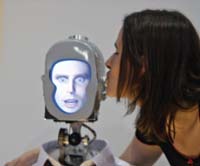
humanoider Roboter H10 auf einer Messe in Berlin |
M. Hackel, S. Schwope: 'A Humanoid Interaction Robot for Information, Negotiation
and Entertainment Use', International Journal of Humanoid Robotics, Volume 1, Number
3, September 2004, World Scientific Abstract This paper presents the design, implementation and application of a humanoid interaction robot (H10). In interdisciplinary cooperation H10 was developed as a case study to operate at points of sale, information desks and demonstrations. If the user given speech input matches an entry of the adaptive database, H10 will react with a suitable answer. Synchronously to the speech generation, face animation and pre-defined gestures of hands and arms are triggered by the core of the system. The principles of the speech, gesture and physical interaction interface as well as some fundamental mechanic and electronic details are described. |
|
|
|
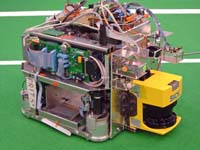
RoboCup Roboter von Philips mit montierter Multi-Sensor Testplatform |
Diploma Thesis 2004: Determination of Limits and Development of Different Sensors
and Algorithms for Autonomous Navigation Abstract In the last few years mobile robots are being increasingly used in different applications. Robots for vacuum cleaning, security and entertainment are used in domestic environments, more and more. Many scientists predict, that robots will be used in every part of our live: television sets are turning or following the observer, cars are driving into parking lots alone, butler robots are cleaning rooms, watering flowers and buying food or robots are rescuing people from burning or collapsed houses, for example. In the future robots or robot technologies are going to be used in nearly every product. This trend is following even in medical use. Most robots in the aforementioned areas have in common, that they are autonomous in decision making, power provision and locomotion. For that they have to see and feel the environment they are working in. A mobile robot consists of mechanics, combinations of sensors and algorithms aligned to the environment the robot is used in. The algorithms are using the sensor measurements and are controlling the robot. |
|
|
|

humanoider Roboter H10 auf der Internetworld 2002 |
IEEE Humanoids 2003 conference: A Humanoid Interaction Robot for Information, Negotiation
and Entertainment Use by Matthias Hackel, Stefan Kellner and Stefan Schwope Abstract This paper presents the design, implementation and application of a humanoid interaction robot (H10). In interdisciplinary cooperation H10 was developed as a case study to operate at points of sale, information desks and demonstrations. If the user given speech input matches an entry of the adaptive database, H10 will react with a suitable answer. Synchronously to the speech generation, face animation and pre-dened gestures of hands and arms are triggered by the core of the system. The principles of speech, gesture and physical interaction interface as well as some fundamental mechanic and electronic details are described. |
|
|
|

XY Farbraum |
Studienarbeit 652 - 2001/03 He (Institut für technische Elektronik, RWTH-Aachen) Implementierung eines Color-Matching-Moduls (CMM) für Apple ColorSync Scanner und Farbwiedergabegeräte (Monitore, Drucker) verarbeiten Farbinformationen jeweils unterschiedlich. Ein Farbmanagementsystem ermöglicht, dass man auf allen Geräten die gleiche Farbdarstellung erhält. Dieses führt Farbanpassungen über einen geräteunabhängigen Farbraum aus und greift hierbei auf Farbprofile zurück, welche vorab für jedes Gerät in einem Kalibriervorgang erstellt wurden. Die eigentlichen Farbumrechnungen werden von einem Color-Matching-Modul (CMM) durchgeführt... |
|
|
|
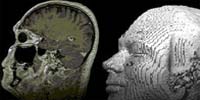
3D Ansicht eines Kopfes berechnet aus 2D Computertomograph-Daten mit MATLAB |
Praktikum Computergrafik und 3D-Visualisierung 7/2000, RWTH-Aachen Umsetzung eines 2D-Magnet-Resonanz-Tomographie-Datensatzes in ein 3D-Bild Ausgangspunkt der folgenden Betrachtungen ist ein Datensatz von 256 Grauwert-Schnittbildern eines menschlichen Kopfes. Mit MATLAB... |
|
|
|
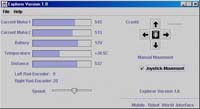
Robotersteuerungs-Programm unter Java |
Java-Embedded-Mikrocomputer-Praktikum I WS 2000/2001, RWTH-Aachen Ethernet / Netzwerkprogrammierung unter Java Ein Aspekt, der für die Programmierung von Applets sehr wichtig ist, stellt die Möglichkeit der Kommunikation zweier Programme über das Internet dar. Java ist von vornherein für die Kommunikation über das Netz ausgelegt... |
|
|
|

Mobiler Roboter Explorer als Entwicklungsumgebung fü Java-Hardwareansteuerung |
Java-Embedded-Mikrocomputer-Praktikum II SS 2000/2001, RWTH-Aachen Explorer - ein mobiler Roboter Der mobile Roboter Explorer ist in dem Java Embedded Mikrocomputer Praktikum II des Lehrstuhls für Allgemeine Elektrotechnik und Datenverarbeitungssysteme, Univ.-Prof. Dr.-Ing. T. Noll, entstanden. Das Praktikum zeigt wie mittels Java externe Hardware über die serielle Schnittstelle des PC's angesprochen werden kann. Die Roboter-Hardware, die Software für Roboter-Hardware und PC waren nicht vorhanden, sondern wurden aus Privatmitteln eigenständig erstellt. Im gesamten Entwicklungsprozess wurden die gesammelten Erfahrungen dokumentiert, um den mobilen Roboter Explorer als neuen Praktikum-Ansatz im Lehrangebot anbieten zu können... |
|
|
|

Logo vom Programm 'Generat', einem Programm zur grafischen Programmierung |
Computer und Automation 6/2000 - Steuerungsebene Dem Code-Schreiben entsagt! Für den Einsatz im industriellen Umfeld wird die grafische Programmierung zunehmend interessanter. Während einige Systeme lediglich den Codiervorgang mittels grafischer Hilfsmittel unterstützen, erlauben andere die interaktive Entwicklung von Programmen - ohne eine einzige Codezeile schreiben zu müssen... |
|
|
|

Staus-LEDs an einer PC Tastatur |
DOS international 7/95 - Tipps für Profis Feststelltasten Die Tasten, deren Status LED-Displays anzeigen, schalten Sie nach Bedarf... |